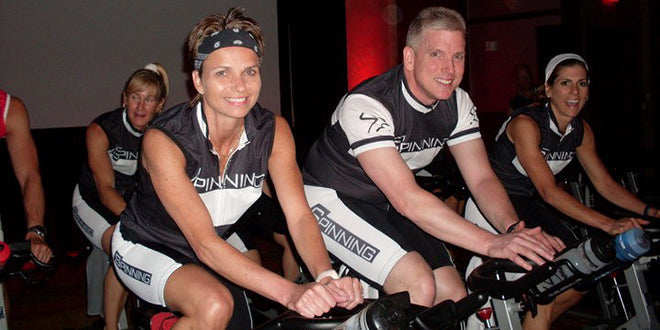How do we know when exercise becomes too taxing? To answer that question, let’s explore the 10 most common injuries from overuse and 10 ways to prevent them.
Due to our exercise schedules, fitness professionals tend to suffer more overuse injuries than the average fitness enthusiast. An overuse injury is a result of excessive wear and tear on the body. Specifically, injuries occur in areas and muscles that are subject to repeated stress, such as the shoulders, hips, back, knees and ankles.
To understand how to avoid overuse, we first need to understand the cause of overuse. The number one cause of overuse is “over-stress.” In fitness, a gradual increase of stress combined with rest strengthens the muscles and muscle tissue, in addition to the cardiorespiratory system. As stress continues, the body becomes stronger and is able to meet and exceed higher levels of effort required. But without proper rest and recovery, certain muscles or joints can get overtaxed.
So how much stress is too much?
Well, in a world of instant gratification and “more is better,” we often forget to allow our body to heal. Without rest, there is no time for the body to rebuild to a stronger state. Therefore, the body becomes weakened and vulnerable to injury rather than stronger. Signs of overuse include constant muscle soreness, joint pain, increased resting heart rate, slower recovery heart rate, a decrease in strength performance, fatigue and anemia.
Basically, there are two types of injuries, acute and chronic. Acute injuries occur suddenly, such as a broken or fractured bone, a sprain and a muscle tear. Chronic injuries, also referred to as overuse injuries, occur over a period of time and are typically a result of repetitive stress, such as shin splints, tendonitis, torn cartilage and plantar fasciitis. Continuing to exercise when the muscles are sore and damaged, could result in a more serious and long-term injury.
Most Common Overuse Injuries
- Joint Pain and Constant Muscle Soreness – Muscle soreness 1-2 days after exercising unconditioned muscles is common. Depending on how intense the workout is, soreness may even persist for up to a week after exercise. However, when those who exercise on a regular basis experience constant muscle soreness and joint pain, this is definitely a sign of overuse. If exercise continues, injury will follow. Resting, icing, stretching and extended warm-ups will aid in the repair of muscle soreness and relieve joint pain.
- Sprains (an overstretching or tearing of a ligament) – Ligaments attach bone to bone. Sprains can range from overstretching the micro-tears in the ligament to complete tears in the ligament. Ankle sprains seem to be most common and occur when the foot is twisted and rolls to the outside. Pain, swelling and bruising may also occur. Minor sprains are often treated with rest, ice and a brace. Once the sprain has healed, balance work and calf strengthening are recommended.
- Achilles Tendonitis – The Achilles heel tendon (back of the ankle) is the largest tendon in the body. It transfers the force of muscle contractions to lift the heel. Achilles tendonitis is an inflammation of the tendon and usually occurs from overuse, such as frequent jumping, excessive pronation of the ankle and foot, and not bringing the heel all the way down to the floor with movements. Rest, ice and stretching are recommended. Those who do not rest and treat Achilles tendonitis can develop chronic symptoms that prevent healing.
- Shin Splints – Shin splints is pain around the tibia (or shin bone) resulting from inflammation of the muscles and tendons around this bone. This inflammation caused by high impact movements, such as running or jumping on hard surfaces over a period of time. Wearing supportive athletic shoes with good arch support, extended rest and icing of the shins are recommended for those who experience this kind of pain. For runners, running on softer surfaces like grass or dirt is recommended.
- Lower Back Pain – Several fitness professionals have experienced a lower back injury at some point in their career. Lower back injuries typically occur from twisting awkwardly, lifting heavy equipment, improper bending, sudden movements when the back muscles are unprepared, and muscle imbalance. Lower back injuries are primarily due to weak or tense muscles. Overloading weak or tense muscles may pull or tear fibers and tendons, causing the back muscles to spasm, which will result in pain. To avoid back injuries, maintain muscle balance by strengthening and stretching the abdominal and back muscles.
- Plantar Fasciitis – The plantar fascia runs the length of the foot and forms the arch of the foot. Plantar fasciitis may occur from over-stretching the arch or from a tight, shortened fascia. This typically occurs with people with high arches. Non- or low-impact exercise, good arch support and rest are recommended for those who suffer from plantar fasciitis.
- Knee Pain/Injury – There are many different causes related to knee pain, but overuse is the most common cause. Patellofemoral syndrome can result from repetitive movement of the patella (kneecap) against the femur (thigh bone), which can damage the tissue under the knee cap. Often, patellofemoral syndrome can lead to misalignment of the kneecap, which causes the cartilage on the side and back of the kneecap to wear. Anterior Cruciate Ligament (ACL) strains and tears are also common and occur from an acute injury, such as a fall, a blow to the outside of the knee or a sudden stop (these are common in sports like basketball and soccer). If you suspect an ACL injury, you should consult with your physician immediately; ACL tears typically require surgery to repair and should be evaluated immediately. To decrease your risk of knee pain/injury, muscle balance is crucial. Supportive athletic shoes and arch support are also strongly recommended.
- Hamstring Strain – A strain is an overstretching or tearing of a tendon or muscle fibers. Think of tendons as springs, they lengthen and return to their original size, unless they are overstretched. Hamstring strain is very common amongst fitness professionals, and it is slow to heal due to the constant stress from walking. Complete healing can take up to one year, so rest and light exercise are recommended when you feel chronic pain in your hamstring.
- Neck Pain – Neck pain is typically a pulled muscle or muscle spasm caused by a sudden movement or holding the neck in one position for a long period of time. Resting, icing and stretching are recommended. Stretching and strengthening the neck muscles can prevent pain and injury in the future.
- Vocal Nodules and Polyps – As fitness professionals, we use our voice every day, and it can get overtaxed just as much as our muscles can. Vocal nodules and polyps are growths on the vocal cords caused by overuse. Repeated use and abuse of the vocal cords results in swollen spots on the vocal cords, and over time, these spots become hard nodules (similar to a callous) or soft polyps (similar to blisters). Symptoms include hoarseness, a scratchy voice, body fatigue and throat pain. Treatment includes voice rest for 2-3 weeks. If the problem persists, consult with your physician. To avoid vocal nodules and polyps, drink fluids while teaching classes, employ visual cues instead of verbal cues, and always use a microphone.
Ways to Prevent Overuse Injuries
Most overuse injuries can be prevented. A few tips to avoid overuse injuries:
- Listen to your body! If you are in pain, your body is giving you a warning sign of a chronic injury. Listen and allow yourself some rest time.
- Begin your exercise program with a proper warm-up. It is tempting to maximize your workout time and get into the intensity right away. But gradually building heat prepares your muscles and joints for more strenuous exercise, and it will reduce the risk of injury down the line.
- Drink plenty of water before, during and after exercise.
- Avoid the same repetitive stress on your body by varying your modality. For instance, if your upper body is feeling stressed from too many strength workouts, consider a Spinning® class for a good, low-impact cardio boost.
- Strengthen and stretch opposing muscles to prevent muscle imbalance. This means whenever you stretch your quads, don’t forget to stretch your hamstrings. And when you lengthen your biceps, give your triceps a stretch soon after. Same goes for the abs and lower back.
- Ensure correct body alignment and form while exercising.
- Pace yourself and modify exercises when necessary.
- Conclude with an adequate cool-down and stretch the muscles used during your workout.
- Wear supportive shoes and breathable, flexible clothing that does not restrict your movement.
- Get enough sleep every night and maintain a healthy diet.
Forgive the pun, but the benefits of rest cannot be stressed enough. Listen to your body and allow sufficient time to rest and recover. Your patience will pay off in the end.






Leave a comment
This site is protected by hCaptcha and the hCaptcha Privacy Policy and Terms of Service apply.